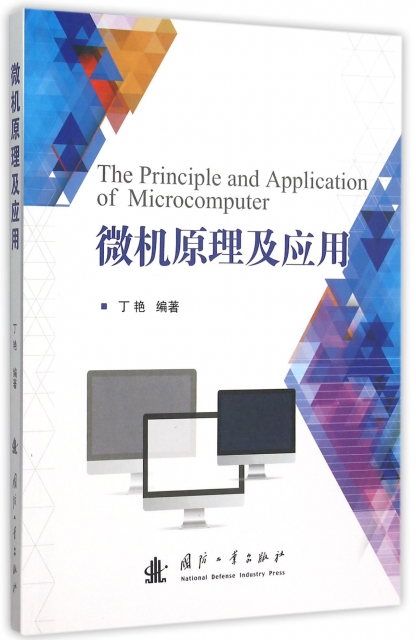| | | | 微機原理及應用 | | 該商品所屬分類:計算機/網絡 -> 計算機原理 | | 【市場價】 | 492-715元 | | 【優惠價】 | 308-447元 | | 【介質】 | book | | 【ISBN】 | 9787118104103 | | 【折扣說明】 | 一次購物滿999元台幣免運費+贈品
一次購物滿2000元台幣95折+免運費+贈品
一次購物滿3000元台幣92折+免運費+贈品
一次購物滿4000元台幣88折+免運費+贈品
| | 【本期贈品】 | ①優質無紡布環保袋,做工棒!②品牌簽字筆 ③品牌手帕紙巾
|
|
| 版本 | 正版全新電子版PDF檔 | | 您已选择: | 正版全新 | 溫馨提示:如果有多種選項,請先選擇再點擊加入購物車。*. 電子圖書價格是0.69折,例如了得網價格是100元,電子書pdf的價格則是69元。
*. 購買電子書不支持貨到付款,購買時選擇atm或者超商、PayPal付款。付款後1-24小時內通過郵件傳輸給您。
*. 如果收到的電子書不滿意,可以聯絡我們退款。謝謝。 | | | |
| | 內容介紹 | |

-
出版社:國防工業
-
ISBN:9787118104103
-
作者:編者:丁艷
-
頁數:330
-
出版日期:2016-01-01
-
印刷日期:2016-01-01
-
包裝:平裝
-
開本:16開
-
版次:1
-
印次:1
-
字數:490千字
-
丁艷編著的《微機原理及應用》以16位微處理器
為核心,全面講述了微型計算機的基本組成、工作原
理以及硬件接口技術。全書共8章,逐一講述了計算
機基礎知識、微型計算機的基本組成及工作原理、16
位微處理器8086/8088CPU的尋址方式、指令繫統、彙
編程序的設計、輸入/輸出接口、存儲器繫統和可編
程定時/計數控制器等內容。本書是作者多年教學經
驗的結晶,內容編排合理,由淺入深,體繫完整,重
點突出並配有豐富的例題及詳盡的注釋。
本書采用全英文編寫,並配有部分漢語注釋,適
合用作普通高等院校非計算機類各專業學生“微型計
算機原理及應用”課程的教材,也可用作成人高等教
育的培訓教材及廣大科技工作者的參考書。
-
Chapter 1 Fundamentals of Computer
1.1 Number System
1.1.1 Basic Number Systems
1.1.2 Conversions between Different Number Systems
1.1.3 Common Data Units
1.2 Logic Algebra and Logic Gates
1.2.1 "OR" Operation and "OR" Gate
1.2.2 "AND" Operation and "AND" Gate
1.2.3 "NOT" Operation and the NOT-Inverter
1.2.4 Basic Rules of Boolean Algebra
1.3 Binary Numbers and Binary Addition/Subtraction
1.3.1 Negative Binary Numbers
1.3.2 Binary Addition
1.3.3 Binary Subtraction
1.3.4 Adder Circuits
1.3.5 Switchable Inverter and Binary Addition/Subtraction Circuit
1.4 Computer Data Formats
1.4.1 ACSII Code
1.4.2 BCD ( Binary-Coded Decimal) Format
1.5 Logic Circuit
1.5.1 Logic Gates
1.5.2 Flip-Flops
1.5.3 Registers
1.5.4 Tri-state Gate and BUS Structure
Tips
Exercise
Chapter 2 System Organization of Microcomputer
2.1 The Basic System Components
2.1.1 CPU (Central Processing Unit)
2.1.2 The System Bus
2.1.3 The Memory Subsystem
2.1.4 The I/O Subsystem
2.2 A Simple Computer
2.2.1 Introduction
2.2.2 Architecture of the Simple Computer
2.2.3 Instruction Set of the Simple Computer
2.2.4 Encoding Instructions
2.2.5 Organization of the Control Unit
2.2.6 Step-by-Step Instruction Execution
Tips
Exercise
Chapter 3 Intel 8086 Microprocessor
3.1 The History of Intel Microprocessor Family
3.2 8086 CPU Architecture
3.2.1 Execution Unit and Bus Interface Unit
3.2.2 Organization of Execution Unit
3.2.3 Organization of Bus Interface Unit (BIU)
3.3 Internal Memory
3.3.1 Addressing Data in Memory
3.3.2 Memory Segment
3.3.3 Segment Boundary
3.3.4 Segment Offset
3.3.5 About Stack Segment
3.4 System Timing
3.4.1 The System Clock
3.4.2 Memory Access Time
3.4.3 Wait States
3.4.4 Bus Cycle
3.5 8086 Pin Assignments and Working Modes
3.5.1 Pins and Their Function Descriptions
3.5.2 Working Modes
3.6 Basic Operations of 8086/8088
3.6.1 Reset Operation
3.6.2 Input and Output for 8086 Minimum Mode
3.6.3 Bus Request and Bus Grant Timing in Minimum Mode
3.6.4 Interrupt Operation
3.6.5 Interrupt Operations in Maximum Mode
Tips
Exercise
Chapter 4 8086 Address Mode and Assembly Instructions
4.1 8086 Assembly Instruction Format
4.2 8086 Addressing Modes
4.2.1 Immediate Addressing
4.2.2 Direct Addressing
4.2.3 Register Addressing
4.2.4 Register Indirect Addressing
4.2.5 Register Relative Addressing
4.2.6 Base-plus-Index Addressing
4.2.7 Base Relative-plus-Index Addressing
4.3 Data Movement Instructions
4.3.1 MOV Instruction
4.3.2 PUSH and POP
4.3.3 XCHG Instruction
4.3.4 XLAT Instruction
4.3.5 LEA Instruction
4.3.6 LDSandLES
4.3.7 Flags Register Movement Instruction
4.3.8 IN and OUT
4.4 Arithmetic Instructions and Logic Instructions
4.4.1 ADD and SUB Function
4.4.2 INC and DEC Function
4.4.3 NEG and CMP Function
4.4.4 MUL and DIV Function
4.4.5 Type Conversion Functions
4.4.6 BCD Conversion Functions
4.4.7 Boolean Operations
4.4.8 Shifting and Rotation
4.5 String Instructions
4.5.1 The Direction Flag
4.5.2 String Data Transfers
4.5.3 String Comparisons
4.6 Program Control Instructions
4.6.1 Program Flow Control Instructions
4.6.2 Machine Control and Miscellaneous Instructions
4.7 The Symbolic Instruction Set
Tips
Exercise
Chapter 5 Directives and Macro Processing
5.1 The Format of the Directives
5.2 Operators and Expression
5.3 Directives
5.3.1 Data Definition and Storage Allocation
5.3.2 EQU Directive
5.3.3 Segment Definition Directive
5.3.4 Assume Directive
5.3.5 PROC Directive
5.3.6 END Directive
5.3.7 ORG Directive
5.3.8 Structures
5.3.9 Records
5.3.10 The PAGE and TITLE Listing Directives
5.3.11 EXTRN/EXTERN Directive
5.3.12 GROUP Directive
5.3.13 INCLUDE Directive
5.3.14 LABEL Directive
5.4 Macro Processing
5.4.1 Macro Definition
5.4.2 Macro Sequence and Procedure Calling
5.4.3 Macro Directives
5.5 DOS Function Calls
5.5.1 The IBM PCBIOS
5.5.2 An Introduction to MS-DOS' Services
5.5.3 MS-DOS Calling Sequence
5.5.4 Frequently Used MS-DOS Functions
5.6 Assembling, Linking and Executing a Program
5.6.1 The Assembler and Linker
5.6.2 Assembling a Source Program
5.6.3 Linking an Object Program
5.6.4 Executing a Program
5.6.5 Using the DEBUG Program
5.6.6 DEBUG Commands Exercise
Tips
Exercise
Chapter 6 Programming with Assembly Language
6.1 Design of Assembly Program
6.2 Simple Procedures Designing
6.3 Branch and Looping Procedures
6.4 Procedure Call and Return
6.5 Programming Examples
Tips
Exercise
Chapter 7 Memory System
7.1 Overview of the Memory
7.1.1 Non-Volatile Memory
7.1.2 Volatile Memory
7.1.3 Performance Index of Memory System
7.2 Memory Devices
7.2.1 SRAM 6264
7.2.2 SRAM6116
7.2.3 DRAM 2164A
7.2.4 EPROM 2764A
7.3 Memory Module Design
7.3.1 Memory Pin Connections
7.3.2 Memory Module Design
7.3.3 Memory Expansion Examples
Tips
Exercise
Chapter 8 I/O Interfaces
8.1 L/O Instructions
8.2 L/O Interfacing Methods
8.3 Serial Interface and Serial Communication
8.3.1 Serial Interface
8.3.2 Basic Serial Transmission Lines
8.3.3 Asynchronous and Synchronous Communication
8.4 8251A Programmable Communication Interface
8.4.1 The Architecture of the 8251A
8.4.2 The Application of the 8251 A
8.4.3 The Initialization of the 8251A
8.5 Parallel Communication Interface
8.6 8255A Programmable Peripheral Interface
8.6.1 The Architecture of the 8255A
8.6.2 The Function Description of the 8255A
8.6.3 The Communication Mode of 8255A
8.6.4 The Initialization and Programming of 8255A
8.7 Programmable Timer and Event Counter
8.8 Intel's 8253 Programmable Timer/Counter
8.8.1 The Architecture of 8253
8.8.2 The Operation Mode Definition of 8253
8.8.3 Examples of 8253 Timer/Counter
Tips
Exercise
Appendix A 8086/8088 Instruction Set Summary
Appendix B Vocabulary and Terms
Reference
| | |
| | | | |
|




